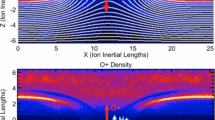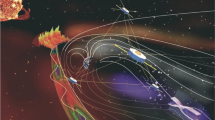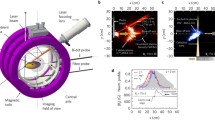Abstract
HYDRA is an experimental hot plasma investigation for the POLAR spacecraft of the GGS program. A consortium of institutions has designed a suite of particle analyzers that sample the velocity space of electron and ions between ≃2 keV/q – 35 keV/q in three dimensions, with a routine time resolution of 0.5 s. Routine coverage of velocity space will be accomplished with an angular homogeneity assumption of ≃16°, appropriate for subsonic plasmas, but with special ≃1.5° resolution for electrons with energies between 100 eV and 10 keV along and opposed to the local magnetic field. This instrument produces 4.9 kilobits s−1 to the telemetry, consumes on average 14 W and requires 18.7 kg for deployment including its internal shielding. The scientific objectives for the polar magnetosphere fall into four broad categories: (1) those to define the ambient kinetic regimes of ions and electrons; (2) those to elucidate the magnetohydrodynamic responses in these regimes; (3) those to assess the particle populations with high time resolution; and (4) those to determine the global topology of the magnetic field. In thefirst group are issues of identifying the origins of particles at high magnetic latitudes, their energization, the altitude dependence of the forces, including parallel electric fields they have traversed. In thesecond group are the physics of the fluid flows, regimes of current, and plasma depletion zones during quiescent and disturbed magnetic conditions. In thethird group is the exploration of the processes that accompany the rapid time variations known to occur in the auroral zone, cusp and entry layers as they affect the flow of mass, momentum and energy in the auroral region. In thefourth class of objectives are studies in conjunction with the SWE measurements of the Strahl in the solar wind that exploit the small gyroradius of thermal electrons to detect those magnetic field lines that penetrate the auroral region that are directly ‘open’ to interplanetary space where, for example, the Polar Rain is observed.
Similar content being viewed by others
References
Binsack, J.: 1966, ‘Plasma Studies with the IMP-2 Satellite’, MS Thesis, MIT.
Christon, S. P., Williams, D. J., Mitchell, D. G., Frank, L. A., and Huang, C. Y.: 1989, ‘Spectral Characteristics of Plasma Sheet Ion and Electron Populations During Undisturbed Geomagnetic Conditions’,J. Geophys. Res. 94, 13409.
Christon, S. P., Williams, D. J., Mitchell, D. G., Huang, C. Y. and Frank, L. A.: 1991, ‘Spectral Characteristics of Plasma Sheet Ion and Electron Populations During Disturbed Geomagnetic Conditions’,J. Geophys. Res. 96, 1.
Green, T. S. and Proca, G. A.: 1970,Rev. Sci. Inst. 41, 1409.
Harvey, P. et al.: 1995, Space Sci. Rev.71, 583.
Herrero, F.: 1991, ‘Light Trap Design Using Multiple Reflections and Solid Angle Attenuation: Application to a Spaceborn Electron Spectrometer’,Appl. Opt. 31, 5331.
Keller, J., Torbert, R., and Vandiver, J.: 1991, ‘A High Speed Pitch Angle Sorter’,Rev. Sci. Inst. 62, 1353.
Mizera, P. F. and Fennel, J. F.: 1977, ‘Signatures of Electric Fields from High and Low Altitude Particle Distributions’Geophys. Res. Letters 4, 311.
Moore, T. E. et al.: 1995, Space Sci. Rev.71, 409.
Ogilvie, K. W., Scudder, J., and Doong, H.: 1978, ‘The Electron Spectrometer on ISEE-1’,IEEE Trans. Geosci. Electronics GE-16, 3, 261.
Ogilvie, K. W. et al.: 1995, Space Sci. Rev.71, 55.
Olbert, S.: 1969, in R. C. Carovillano, J. F. McClay, and H. R. Radoski (eds.),Physics of the Magnetosphere, D. Reidel Publ. Co., Dordrecht, Holland, p. 641.
Olbert, S., Egidi, A., Moreno, G., and Pai, L. G.: 1968,Trans. AGU 48, 149.
Russell, C. T. et al.: 1995,Space Sci. Rev. 71, 563.
Scudder, J. D., Sittler, E. C., Jr., and Bridge, H. S.: 1981, ‘A Survey of the Plasma Electron Environment of Jupiter’,J. Geophys. Res. 86, 8157.
Vasyliunas, V. M.: 1968, ‘A Survey of Low Energy Electrons in the Evening Sector of the Magnetosphere with OGO 1 and OGO 3’,J. Geophys. Res. 73, 2839.
Whipple, E. C.: 1978, ‘(U, B, K) Coordinates: A Natural System for Studying Magnetospheric Convection’,J. Geophys. Res. 83, 4318.
Author information
Authors and Affiliations
Rights and permissions
About this article
Cite this article
Scudder, J., Hunsacker, F., Miller, G. et al. Hydra — A 3-dimensional electron and ion hot plasma instrument for the POLAR spacecraft of the GGS mission. Space Sci Rev 71, 459–495 (1995). https://doi.org/10.1007/BF00751338
Received:
Issue Date:
DOI: https://doi.org/10.1007/BF00751338




